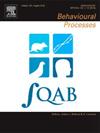筑巢彩鹳(Mycteria leucocephala)体温调节行为的性别差异、昼夜变化和季节变化趋势
IF 1.3
4区 生物学
Q4 BEHAVIORAL SCIENCES
引用次数: 0
摘要
为应对热应激,鹳鸟通过排泄物弄湿腿部(称为尿湿症),并进行展翅行为,即翅膀半展成倒三角形。虽然一些研究强调了尿湿是一种重要的降温机制,并提出了展翅可能具有的体温调节功能,但这些行为在整个繁殖季节的性别比较和趋势仍未得到探讨。在此,我们通过非侵入式摄像技术探讨了在印度德里国家动物公园筑巢的画眉鹳(Mycteria leucocephala)野生种群的体温调节情况。温度、湿度和风速对尿失禁和展翅行为都有显著影响。与雌性鹳相比,雄性鹳患尿道炎的比例更高,展翅时间更长。观察到的季节和昼夜差异表明,在一天中最热的时间段和8-9月筑巢季节的早期,尿湿和展翅行为较多。随着筑巢季节的到来,这两种行为的发生率有所下降,直到 11 月环境温度下降时才有所减少。本文章由计算机程序翻译,如有差异,请以英文原文为准。
Sex-based differences, diurnal and seasonal trends in thermoregulatory behaviour of nesting Painted Stork (Mycteria leucocephala)
To cope with heat stress, storks wet their legs by excreting on them, known as urohidrosis, and perform wing-spreading in which the wings are half extended in the form of an inverted triangle. While several studies have highlighted the role of urohidrosis as an important cooling mechanism and suggested a possible thermoregulatory function of wing-spreading, sex-based comparisons and trends of these behaviours throughout the breeding season remain unexplored. Here we explore thermoregulation in a wild population of Painted Storks (Mycteria leucocephala) nesting in the National Zoological Park, Delhi, India, through the non-invasive videography technique. Temperature, humidity and wind speed significantly influenced both urohidrosis and wing-spreading behaviours. Male storks exhibited higher rates of urohidrosis and spend more time wing-spreading compared to females. Seasonal and diurnal differences were observed with more urohidrosis and wing-spreading during the hottest hours of the day and early part of the nesting season in August-September. The rate of both behaviours declined as the nesting season progressed till November when ambient temperatures dropped.
求助全文
通过发布文献求助,成功后即可免费获取论文全文。
去求助
来源期刊

Behavioural Processes
生物-动物学
CiteScore
2.70
自引率
7.70%
发文量
144
审稿时长
4-8 weeks
期刊介绍:
Behavioural Processes is dedicated to the publication of high-quality original research on animal behaviour from any theoretical perspective. It welcomes contributions that consider animal behaviour from behavioural analytic, cognitive, ethological, ecological and evolutionary points of view. This list is not intended to be exhaustive, and papers that integrate theory and methodology across disciplines are particularly welcome.
 求助内容:
求助内容: 应助结果提醒方式:
应助结果提醒方式:


